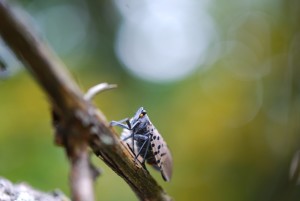Researchers Studying Potential Threat From Spotted Lanternfly

Spotted lanternfly feeding on a wild grapevine. Photo credit: Greg Hoover, Dept. of Entomology, Penn State University
In 2014, an invasive pest called spotted lanternfly was discovered in Berks County, PA. However, Penn State Professor of Entomology Michael Saunders suspects the insect has been here longer than that.
“It appears as if they came in on some decorative masonry stone imported from somewhere in Asia as egg masses on the stone,” Saunders says.
The population is formidable, but it’s centered within a quarantine zone in Berks County. Saunders says the state’s response to the pest has been impressive. But, there is still some reason for concern.
“Anytime you have any invasive organism, there’s concern just because it could upset ecological balances,” he says. “But in the case of this insect, we know from its recent introduction into South Korea that it became a major agricultural pest and, in particular, the South Koreans saw it as a great problem in grape vineyards.”
That’s why Saunders became involved. As the state grape entomologist, he’s trying to assess the potential impact of this insect on the grape industry. One of the challenges is that fieldwork must be limited to the quarantine zone. Therefore, Saunders and his colleagues have had to establish their own mini-vineyards within the quarantine area.
They’ve also built cages to confine the insect with the plant to learn more about its behavior and mating habits. They’ve been able to grow lanternfly from newly hatched through fourth instar.
“It seems as if by the time they get to the fourth instar, they’re not so interested in feeding on grape anymore,” Saunders says. “Whether these laboratory observations are consistent with what we see in the field remains to be seen.”
In other plants, it appears that the insects aggregate and “gang feed” to suck sap from the phloem, ultimately wilting the plant.
“When a bunch of them feed at the same time, they’re pulling a lot of fluid out of that plant,” Saunders says. He adds that there are about 57 different hardwoods the pest is known to feed on, and it has a very soft spot for an invasive plant called Tree of Heaven.
So far, though, the pest is somewhat of an enigma when it comes to grapes. Saunders and his colleagues created a quarantine facility in the basement of their building where they have been rearing lanternfly on grapevines. These vines seem to show no sign of feeding damage.
“We had 100 of them on one small, three-bud cutting that we rooted in a pot, and that’s the healthiest-looking grapevine I’ve ever seen,” Saunders says. “I’m having a hard time wrapping my head around this.”
Other researchers are trying to identify pheromones that might be used in communication between the males and females, what causes them to aggregate, when they feed and if they’re using sound to communicate like many other planthoppers do, Saunders says.
“It certainly appears as if there’s a lot of acoustic signaling that’s going on, either through the drumming of the substrate or some other means of making noise,” he adds.
The insects are very fragile, too. “If you catch a bunch and bring them back in a cage, by the time you get there, they’re likely to all be dead,” he says. “It seems so weird that something that acts so fragile has the potential to be such a serious pest.” He notes that any contact insecticide will likely kill the pest.
How Concerned Should Growers Be?
Spotted lanternfly is more likely to be spread by people than by its own wings, as the insect tends to lay its egg masses on smooth surfaces.
“So that egg mass could be laid on your car or on a boat trailer that you haven’t been paying attention to out behind the shed, and then you decide to go to the lake next summer right when the egg masses are hatching,” Saunders says.
As of now, though, Saunders doesn’t believe there’s too much for grape growers to be concerned about. His primary focus is on continuing to study the pest to determine its potential threat to the industry.
There’s not currently much information on spotted lanternfly, and a lot of the literature that is out there appears to be inaccurate. For example, Korean literature describes what the lethal winter temperatures are for the insect but, if it were correct, the pest would not have survived the past two winters in Pennsylvania, according to Saunders.
Essentially, Saunders is starting from scratch.
“That’s an unusual situation to be in and, as an entomologist, it’s a wonderful situation to be in,” he says. “Everything we learn is going to be new.”










